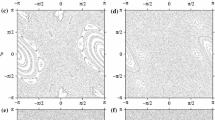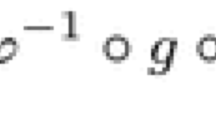Summary
By following the bifurcation sequences of two main families of periodic orbits of the Hamiltonian\(H(\alpha ) = (\dot x^2 + \dot y^2 + x^2 y^2 )/2 + \alpha (x^2 + y^2 )/2\) as α→0, we show that they all destabilize in a systematic way (mainly by period-doubling bifurcations), and are unstable at α=0, suggesting that there is no stable periodic orbit in that limit. Still, despite this, and related results by other authors, it has not been rigorously proved to date that the HamiltonianH(0) is completely chaotic,i.e. that all of its periodic orbits are unstable.
Riassunto
Seguendo le sequenze di biforcazione di due principali famiglie di orbite periodiche dell’Hamiltoniana\(H(\alpha ) = (\dot x^2 + \dot y^2 + x^2 y^2 )/2 + \alpha (x^2 + y^2 )/2\) mentre α→0, si mostra che tutte destabilizzano in un modo sistematico (principalmente per biforcazioni a raddoppio di periodo) e sono instabili a α=0, il che suggerisce che non c’è nessuna orbita periodica stabile in quel limite. Tuttavia, nonostante ciò e i risultati riportati da altri autori non è stato rigorosamente provato fino ad ora che l’hamiltonianaH(0) è completamente caotica, cioè che tutte le sue orbite periodiche sono instabili.
Similar content being viewed by others
References
J. Ford: inFundamental Problems in Statistical Mechanics, edited byE. G. D. Cohen, Vol. 3 (North Holland, Amsterdam, 1975).
M. A. Olshanetsky andA. M. Perelomov:Phys. Rep.,71, 313 (1981).
V. I. Arnol’d andA. Avez:Ergodic Problems in Classical Mechanics (Benjamin, New York, N.Y., 1974).
J. Moser:Stable and Random Motions (Princeton University Press, Princeton, N.J., 1973).
M. C. Gutzwiller:J. Math. Phys. (N.Y.),14, 139 (1973); see alsoJ. Math. Phys. (N.Y.),18, 806 (1977).
R. L. Devaney:J. Diff. Eqs.,29, 253 (1978); also inLecture Notes in Mathematics, Vol.668 (Springer-Verlag, 1978).
S. G. Matinyan:Sov. J. Part. Nucl.,16, 276 (1985).
G. K. Savvidi:Phys. Lett. B,130, 303 (1983).
S. G. Matinyan et al.:Sov. Phys. JETP,53, 421 (1981).
A. Carnegie andI. C. Percival:J. Phys. A,17, 801 (1984).
G. Casati, G. Comparin andI. Guarneri:Phys. Rev. A,26 (1982).
F. Vivaldi, G. Casati andI. Guarneri:Phys. Rev. Lett.,51, 727 (1983).
M. Abramowitz andI. Stegun:Handbook of Mathematical Functions (Dover, New York, N.Y., 1965).
H. T. Davis:Introduction to Nonlinear Differential and Integral Equations (Dover, New York, N.Y., 1962).
E. T. Whittaker andG. N. Watson:A Course in Modern Analysis (Cambridge 4th ed., 1927).
W. Magnus andS. Winkler:Hill’s Equation (Dover, New York, N.Y., 1979).
R. C. Churchill, G. Pecelli andD. L. Rod:Arch. Ration Mech. Anal.,73, 313 (1980).
T. Bountis:Physica D,3, 577 (1981).
A. J. Lichtenberg andM. A. Lieberman:Regular and Stochastic Motion (Springer-Verlag, Berlin, 1983).
G. Contopoulos:Lett. Nuovo Cimento,37, 257 (1983).
J. L. Lebowitz andO. Penrose:Phys. Today,23 (1973).
Author information
Authors and Affiliations
Additional information
To speed up publication, the authors of this paper have agreed to not receive the proofs for correction.
Traduzione a cura della Redazione.
Rights and permissions
About this article
Cite this article
Sohos, G., Bountis, T. & Polymilis, H. Is the Hamiltonian\(H = (\dot x^2 + \dot y^2 + x^2 y^2 )/2\) completely chaotic?completely chaotic?. Nuov Cim B 104, 339–352 (1989). https://doi.org/10.1007/BF02728404
Received:
Published:
Issue Date:
DOI: https://doi.org/10.1007/BF02728404




